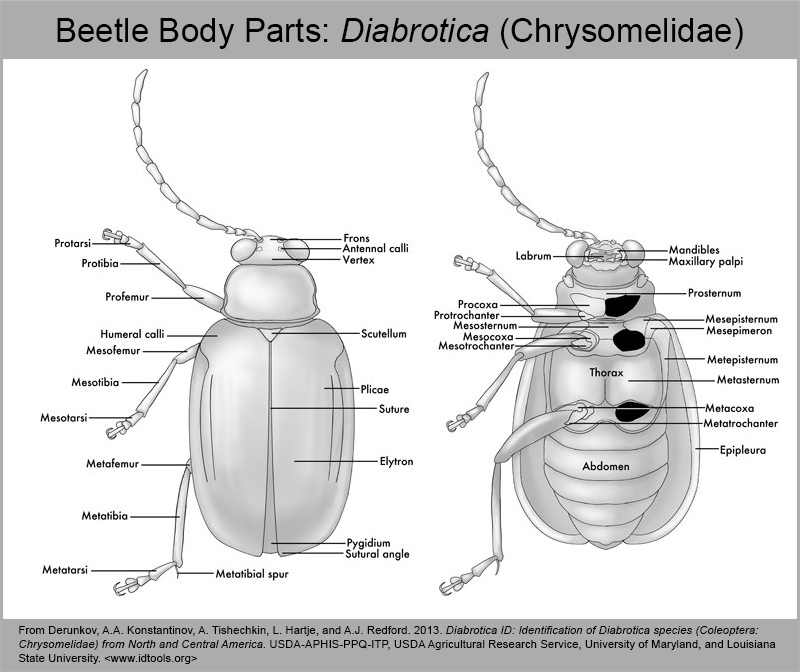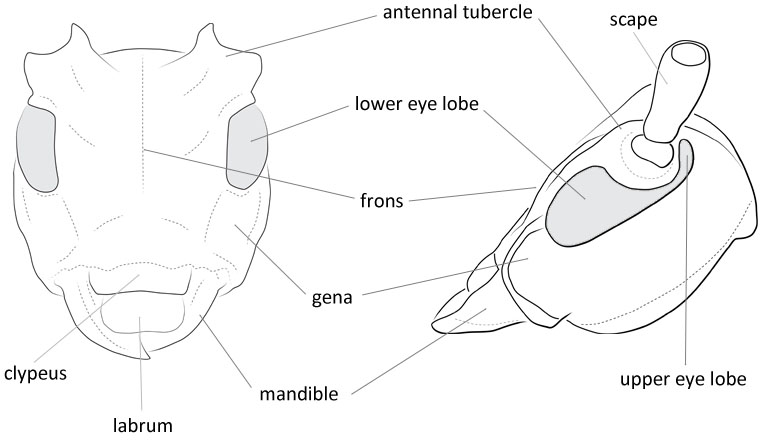Body length: 5.5–11.5 mm.
Eyes: eye interommatidial setaeseta:
a sclerotized hair-like projection of the cuticle
absent, eye entire/shallowly emarginateemarginate:
notched at the margin , eye ommatidial density fine.
, eye ommatidial density fine.
Antennaeantenna:
in larval and adult insects, paired segmented appendages, borne one on each side of the head, functioning as sense organs and bearing a large number of sensilla
: antennal length barely surpassing pronotumpronotum:
the upper and dorsal part of the prothorax
or reaches between basebase:
the part of any appendage or structure that is nearest the body
and end of elytraelytron:
the leathery forewing of beetles, serving as a covering for the hind wings, commonly meeting opposite elytron in a straight line down the middle of the dorsum in repose
, antennal flagellar segments elongateelongate:
much longer than wide
, scapescape:
the first proximal segment of the antenna smooth/punctate at apexapex:
smooth/punctate at apexapex:
end of any structure distad to the base
, antennal scapescape:
the first proximal segment of the antenna ≥ segment 3.
≥ segment 3.
Pronotumpronotum:
the upper and dorsal part of the prothorax
: pronotumpronotum:
the upper and dorsal part of the prothorax
shape subquadratesubquadrate:
not quite a square
or longer than wide, pronotumpronotum:
the upper and dorsal part of the prothorax
lateral armature absent.
Prosternum: prosternal processprosternal process:
a posterior extension of the prosternum between the coxae dilated at apexapex:
dilated at apexapex:
end of any structure distad to the base
, procoxal cavities open posteriorly.
Elytraelytron:
the leathery forewing of beetles, serving as a covering for the hind wings, commonly meeting opposite elytron in a straight line down the middle of the dorsum in repose
: elytral length reaching or close to end of abdomen, elytral apicesapex:
end of any structure distad to the base
emarginate or with tooth or spinespine:
a protuberance with an acute (sharp) distal end
, elytral color pattern present.
Legs: visible tarsomerestarsomere:
subdivision or article of the tarsus, usually numbering from two to five : 4, femora clavateclavate:
: 4, femora clavateclavate:
thickening gradually toward the tip
, rarely slender, protibial spursprotibial spur:
sclerotized spine(s) located at the distal tibia; can be single, double, or absent : 2, tarsal clawstarsal claw:
: 2, tarsal clawstarsal claw:
usually paired claws of the pretarsus, at the distal end of the leg simple.
simple.
Antennaeantenna:
in larval and adult insects, paired segmented appendages, borne one on each side of the head, functioning as sense organs and bearing a large number of sensilla
more or less distantly inserted, intervening space fairly even; metepisternummetepisternum:
the episternal portion of the pleuron on the posterior thoracic segment broad, 2–3 times as long as broad. Front of head lacking distinct carinaecarina:
broad, 2–3 times as long as broad. Front of head lacking distinct carinaecarina:
an elevated ridge or keel, not necessarily high or acute
. Antennaeantenna:
in larval and adult insects, paired segmented appendages, borne one on each side of the head, functioning as sense organs and bearing a large number of sensilla
more or less slender, with segments generally not toothed; prothorax generally longer than broad. First posterior tarsal segment generally at least twice as long as following two segments combined; posterior femora usually extending beyond elytral apicesapex:
end of any structure distad to the base
(Gressitt 1951Gressitt 1951:
Gressitt JL. 1951. Longicorn beetles of China. Longicornia, Paris 2: 1–667, 22 pls.).
Pseudosphegesthes, Neoclytus, Xylotrechus
In this genus there are no distinct carinaecarina:
an elevated ridge or keel, not necessarily high or acute
on the fronsfrons:
the upper anterior portion of the head capsule, usually a distinct sclerite between the epicranium and clypeus or transversetransverse:
or transversetransverse:
broader than long
carinaecarina:
an elevated ridge or keel, not necessarily high or acute
on the pronotumpronotum:
the upper and dorsal part of the prothorax
.
eastern Palearctic, Indomalaya, Afrotropic: Congo, Australasia
broadleaf; Cupressus; Pinus
87 spp. + 5 more subspecies. Conifers: P. parvulus Gahan (Makihara et al. 2008Makihara et al. 2008:
Makihara H, Mannakkara A, Fujimura T, and Ohtake A. 2008. Checklist of longicorn coleoptera of Sri Lanka (1) Vesperidae and Cerambycidae excluding Lamiinae. Bulletin of the Forestry and Forest Products Research Institute, Ibaraki 7 (2) 407: 95–110, 26 figs.).
Amauraesthes Chevrolat, 1863
Perissus Chevrolat, 1863